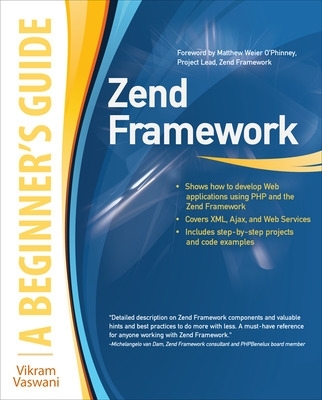Beginner's Guide
2 total works
Essential Skills--Made Easy!
Leverage the power of the Zend Framework to supercharge your PHP development! Zend Framework: A Beginner's Guide covers key features, including model-view-controller implementation, routing, input validation, internationalization, and caching, and shows you how to use them in a practical context. The book walks you through the process of building a complete Web application with the Zend Framework, starting with the basics and then adding in more complex elements, such as data pagination and sorting, user authentication, exception handling, localization, and Web services. Debugging and performance optimization are also covered in this fast-paced tutorial.
Designed for Easy Learning
- Key Skills & Concepts--Chapter-opening lists of specific skills covered in the chapter
- Ask the Expert--Q&A sections filled with bonus information and helpful tips
- Try This--Hands-on exercises that show you how to apply your skills
- Notes--Extra information related to the topic being covered
- Tips--Helpful reminders or alternate ways of doing things
- Cautions--Errors and pitfalls to avoid
- Annotated Syntax--Example code with commentary that describes the programming techniques being illustrated
Read-to-use code at www.zf-beinners-guide.com and www.mhprofessional.com/computingdownload.
Publisher's Note: Products purchased from Third Party sellers are not guaranteed by the publisher for quality, authenticity, or access to any online entitlements included with the product.
Essential Skills--Made Easy!
Learn how to build dynamic, data-driven Web applications using PHP. Covering the latest release of this cross-platform, open-source scripting language, PHP: A Beginner's Guide teaches you how to write basic PHP programs and enhance them with more advanced features such as MySQL and SQLite database integration, XML input, and third-party extensions. This fast-paced tutorial provides one-stop coverage of software installation, language syntax and data structures, flow control routines, built-in functions, and best practices.
Designed for Easy Learning:
Key Skills & Concepts--Lists of specific skills covered in the chapterAsk the Expert--Q&A sections filled with bonus information and helpful tips
Try This--Hands-on exercises that show how to apply your skills
Notes--Extra information related to the topic being covered
Tips--Helpful reminders or alternate ways of doing things
Cautions--Errors and pitfalls to avoid
Self-Tests--Chapter-ending quizzes to test your knowledge
Annotated Syntax--Example code with commentary that describes the programming techniques being illustrated

